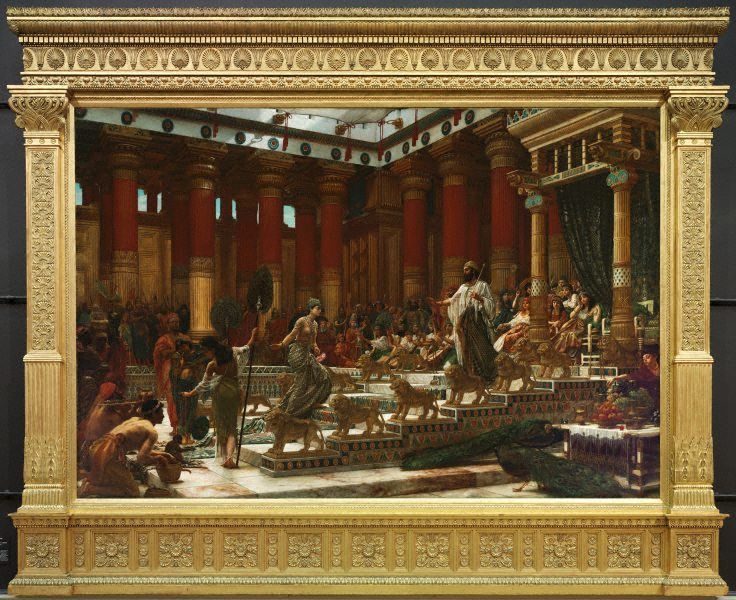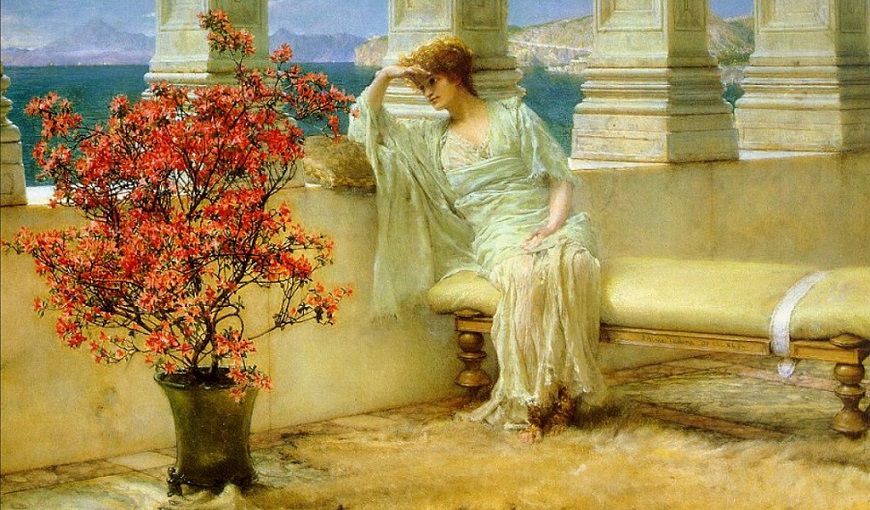NEW ART AT KMHG
- 4 May 2020
- Lara van der Raaij
Katherine Mansfield House & Garden’s recent re-interpretation introduced a number of new artworks to the house. The works are all representative of European art from the period that the house has been restored to (1888-1907) and were painted in a style known as ‘academic art’.
Originating from the academies of Renaissance Italy and specifically influenced by the standards of the French Académie des Beaux-Arts, the academic style was characterised by polished technical skill and historic subject matter. As illustrated by the prints of these artworks now on display at Katherine Mansfield House & Garden, academy artists preferred classical, biblical, mythological and allegorical subjects.
Find out the story behind each of these four artworks, then come and find them in the house!

Original of 'The visit of the Queen of Sheba to King Solomon'. Courtesy of the Art Gallery of New South Wales.
Title: 'The visit of the Queen of Sheba to King Solomon'
Year: 1890
Artist: Sir Edward Poynter (1836-1919)
Subject matter: Biblical
‘The visit of the Queen of Sheba to King Solomon’ depicts the biblical story of the first encounter of the Queen of Sheba and King Solomon. Solomon’s unprecedented wisdom led to the spread of his fame throughout the Middle East, including to Sheba in the south of Egypt. The Queen of Sheba arrived bearing luxurious gifts of gold, spices and precious stones. King Solomon reciprocated by granting ‘all her desire, whatsoever she asked'.
Sir Edward Poynter was obsessed with the accuracy of details, and this painting is no exception. The painting features a combination of classical architectural features which are continued in the original painting's frame, with its own entablature and columns.
The original painting is held in the collection of the Art Gallery of New South Wales (AGNSW). The AGNSW is only the second owner of the painting, having bought it from the Thomas McLean Gallery, London, in 1892. Thomas McLean bought the painting directly from the artist in 1890.
Sir Edward Poynter is most famous for his large historical paintings, corresponding with mainstream interest in Oriental subjects during the late 1800s. This was a period of significant archaeological discoveries from Egypt and the Middle East. While in Rome trying to recover from ill health as a 17-year-old, Poynter met the artist Frederic Leighton who made a great impression on him. Leighton's painting 'Flaming June' is discussed below.
.jpg?202005040629)
'Flaming June'. Courtesy of Wikimedia.
Title: 'Flaming June'
Year: 1895
Artist: Sir Frederic Leighton (1830-1896)
Subject matter: Classical
‘Flaming June’ is considered to be Sir Frederic Leighton’s greatest work. The painting was well-known and widely reproduced during the Victorian era. The woman pictured asleep on a marble bench was originally intended to be a motif in another of Leighton’s paintings, ‘Summer Slumber.’ However, Leighton liked it so much, he kept it as a separate work. The woman in a state of repose pictured in ‘Flaming June’ is loosely based on Michelangelo’s statue of 'Night'. ‘Flaming June’ is one of the most famous examples of the Victorian love of unconscious women in paintings; either sleeping, entranced or dead.[1] The toxic oleander branch pictured behind the woman hints at the latter possibility.
The model for the painting is believed to be Dorothy Dene, a stage actress and artist’s model. She was one of Leighton’s favourite models and, some argue, his muse. He aided her career, assisted with her education and introduced her to society. The relationship between Dene and Leighton is said to have inspired George Bernard Shaw’s Pygmalion, later adapted to stage and screen as My Fair Lady.
The painting went missing after a period of loan to the Ashmolean Museum, Oxford, in the early 1900s. Decades later, it was discovered boxed in over a chimney of a house in Battersea, London. At the time Victorian art was out of fashion and a young Andrew Lloyd Webber nearly managed to buy it for £50, but he hadn’t yet become a famous composer and his grandmother wouldn’t loan him the money. In 1963, ‘Flaming June’ was bought in Amsterdam for $1,000 by Puerto Rican businessman and politician Luis A. Ferre. The painting remains the prized artwork of the Museo de Arte de Ponce, Puerto Rico, which Ferre founded.
British painter Sir Frederic Leighton was internationally recognised in his lifetime. Leighton painted historical, biblical and classical subject matter in an academic style. In 1855, Queen Victoria bought Leighton’s first major work. In 1878, Leighton became president of the Royal Academy of the Arts, a position he held until his death. For his contribution to British art, Leighton was rewarded with various honours including a knighthood, baronetcy and peerage. He is buried at St Paul’s Cathedral.
Leighton’s purpose-built house and studio in Holland Park, London, has been turned into a museum, Leighton House Museum. The museum collection contains a range of Leighton’s own work, the work of his contemporaries and Leighton’s collection of Old Masters. During Leighton’s lifetime, the house was extended and decorated to become a ‘private palace of art’, its centrepiece being the Arab Hall, which has a golden dome, intricate mosaics and walls lined with beautiful Islamic tiles.

'Her Eyes are with Her Thoughts and They are Far Away'. Courtesy of WikiArt.
Title: 'Her Eyes are with Her Thoughts and They are Far Away' (also known as 'Wandering Longings')
Year: 1897
Artist: Sir Lawrence Alma-Tadema (1836-1912)
Subject matter: Classical
We haven’t been able to find out a lot about this specific painting by Sir Lawrence Alma-Tadema, which is held in a private collection, but the model may have been his second wife, Laura, who was also an artist. Laura Alma-Tadema was a painter of domestic scenes featuring women and children. Her style was inspired by 17th-century Dutch paintings and was less pedantic than her husband’s academic style. A number of her paintings were exhibited at the Royal Academy during her lifetime. Laura frequently modelled for her husband’s paintings, and Lawrence also featured in Laura’s paintings.
Dutch-born Lourens Alma Tadema (he later Anglicised his first name and, over time, his surnames have been hyphenated) studied at the Royal Academy of Antwerp, eventually settling in England in 1870. He is one of the most well-known and celebrated romantic artists of late 19th-century Britain. He painted luxurious classical subjects, featuring marble interiors and bright Mediterranean sea and sky. After falling out of favour at the end of his life, Alma-Tadema’s work had a resurgence of popularity in the 1960s as source material for Hollywood movies. The Ten Commandments (1956) and Ben Hur (1959) took direct inspiration from the architectural accuracy of Alma-Tadema’s paintings, grounded in the artist’s personal research. The large, wide-angle drama of his paintings also inspired the sets for the Best Picture winner Gladiator (2000).
Auckland Art Gallery has one of Sir Lawrence Alma-Tadema’s paintings, 'Cleopatra' (1877), in their collection. The painting depicts the side profile of the Egyptian queen reclining against animal skins, for which Laura was used as a model.

'The Progress of Spring'. Courtesy of the Dahesh Museum of Art.
Title: 'The Progress of Spring'
Year: 1905
Artist: Charles Daniel Ward (1872-1935)
Subject matter: Allegorical
Exhibited at the Royal Academy in 1905, ‘The Progress of Spring’ is thought to have been inspired by the Roman writer Virgil’s poem, Georgics. Virgil’s second official work, Georgics was written as poetic instruction for tending to the land and farm animals. The comfort and joy Virgil found in the countryside is clearly translated to Ward’s allegorical painting of spring.
The 'progress of life' is symbolised by a budding courtship, and lambs pictured grazing in the background. The suitors form part of a procession of young women gathering flowers in the centre of a woodland. A boy playing the flute leads the crowd, possibly referring to Faunus (the Roman equivalent of Pan).
'The Progress of Spring' is held in the collection of the Dahesh Museum of Art, New York. The Dahesh Museum of Art is dedicated to the work of academy trained European artists of the 19th and early 20th century.
Charles Daniel Ward was born in Taunton, England, and studied at the Royal College of Art. He was a painter of portraits, landscapes and figural compositions and regularly exhibited at the Royal Academy, London. His wife Charlotte Blakeneney (Ward) was also a well-known artist who exhibited in London and at the Paris Salon. She was president of the Society of Women Artists and painted in the open air. 'The Progress of Spring' is Charles Daniel Ward's most famous work.
References
[1] Sherwin, Skye. 'Frederic Leighton's Flaming June: the Mona Lisa of the Southern Hemisphere', The Guardian, 16 Dec 2016.
